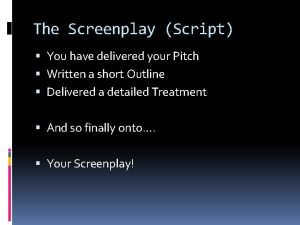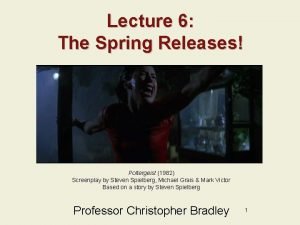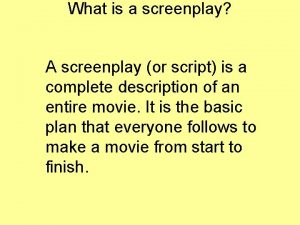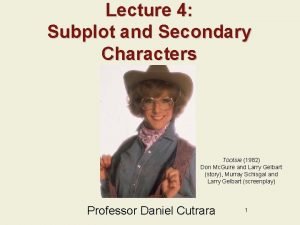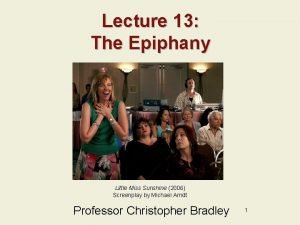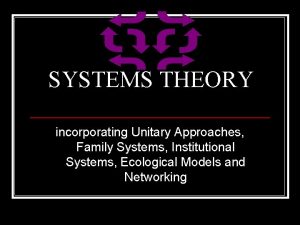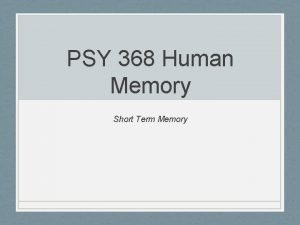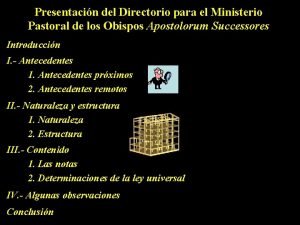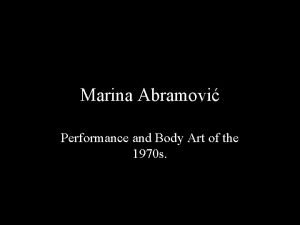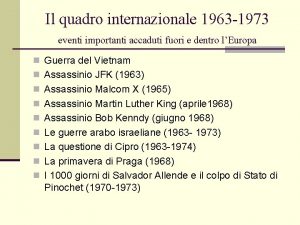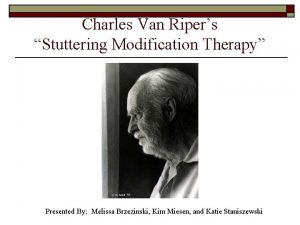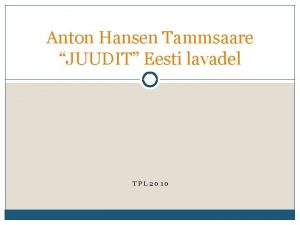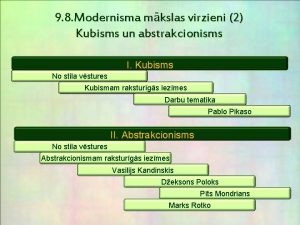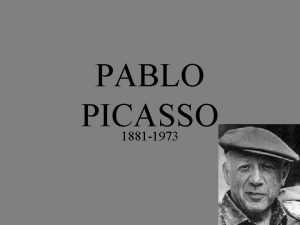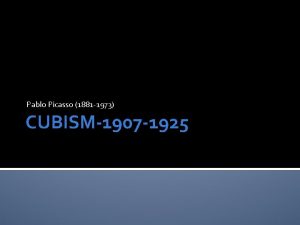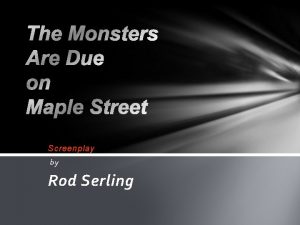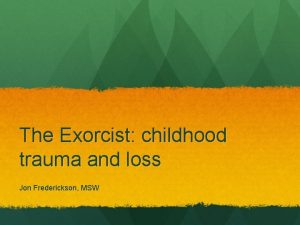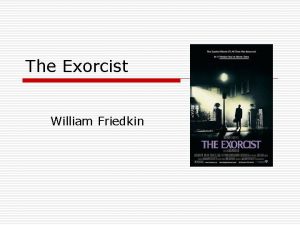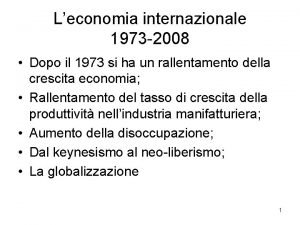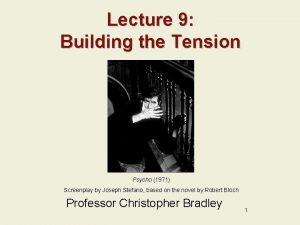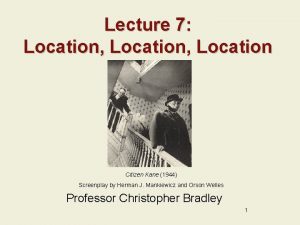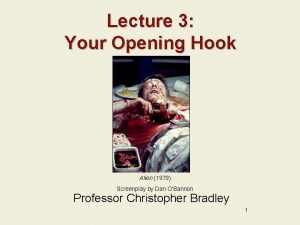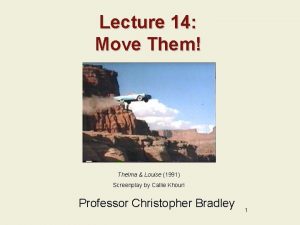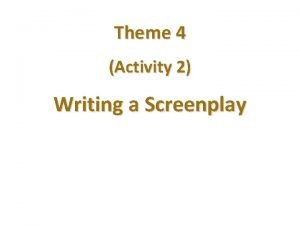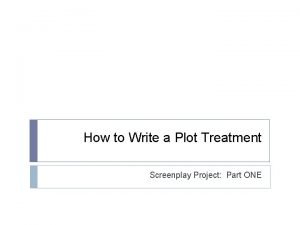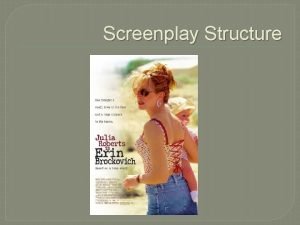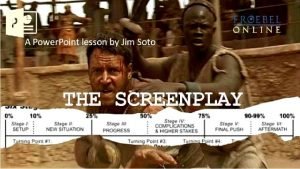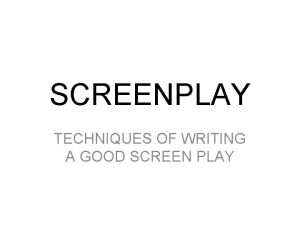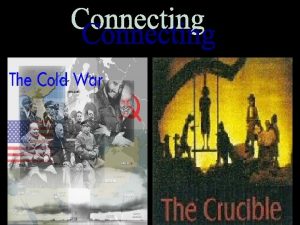Lecture 2 Story Ideas The Exorcist 1973 Screenplay

































- Slides: 33

Lecture 2: Story Ideas The Exorcist (1973) Screenplay by William Peter Blatty Professor Christopher Bradley 1

Previous Lesson • Discovering Inspiration • Structure and the Screenwriting Process • What writing strategies work for you? • Writing Exercise #1: Three Story Ideas Death in Venice (1971) Screenplay by Luchino Visconti & Nicola Badalucco. Based on the novel by Thomas Mann

In this Lesson • Why good writing is life and death for humanity • Conflict and Goals • Action and Dialogue • Building to the Climax • Writing Exercise #2: – Select one story idea and create a logline for it! Aliens (1986) Screenplay by James Cameron

Why Your Writing Matters A Streetcar Named Desire (1951) Screenplay by Tennessee Williams Lesson 2: Part I 4

Story - 1 • We create story in what we tell ourselves about the reality around us. • We also tell each other stories to explain our lives, to help define our joys and struggles. 5

Story - 2 • We find story in television shows, movies, stage plays, literature, video games, comic books and even the news. • Even if news is “fair and balanced” it isn’t strictly “true. ” By necessity, journalists take pieces of reality to create narrative, make arguments and form meaning. 6

Story - 3 • In psychotherapy, a patient takes the true events of his or her life and re -writes the meaning. – A meaning that keeps you stuck, such as, “I can’t succeed because I was disfigured in the accident that killed my mother” might become “Every success I create honors my mother’s memory. ” 7

Story - 4 • The screen stories that live with you for the rest of your life are the stories that allow you to re-write meaning of your life for yourself and become more powerful. • “We teach best what we most need to learn. ” You’ll teach yourself with what you write. 8

Story - 5 • “When storytelling goes bad, the result is decadence. ” –Aristotle • It’s not about lying about how bad it is, but rather about telling the truth in a powerful way. – For example: Requiem for a Dream 9

Story - 6 The Public Enemy (1931) Screenplay by Kubek Glasmon and John Bright Adaptation by Harvey F. Thew Click here to view the 1930 Hollywood Production Code 10

Form • Stories order the chaos of the world. • Reality is allowed to be random and chaotic. Stories are not! • Therefore, stories obey certain principles and adhere to certain forms. • In life, experiences often become meaningful with reflection over time. Stories are processed by the writer to have meaning now. 11

Detail in Story • One of the ways that we create such meaning in stories is by the authentic detail. And authentic detail comes from being a master observer of LIFE. • The detail creates verisimilitude, which allows for a story to approximate the truth of real life. • We include detail to make our stories more comic, dramatic, frightening, aweinspiring, etc. 12

Using Detail • • A generic story about a sweet kindergarten teacher who may or may not be damaging children emotionally can be effective and evoke emotion. But give that same teacher a thick, ugly scar under her satin scarf, or a scorpion tattoo hiding under her pink cashmere sweater, and you have detail that makes for a more compelling story. There is suddenly more uncertainty and possible 13 danger.

Example of Use of Detail PULP FICTION INT. WILLIS LOCKER ROOM (AUDITORIUM) – NIGHT In the room, black boxer FLOYD RAY WILLIS lies on the table– dead. His face looks like he went dunking for bees. INT. COFFEE SHOP - MORNING Vincent throws some money on the table and Jules grabs the briefcase. Then, to the amazement of the Patrons, the Waitresses, the Cooks, the Bus Boys and the Manager, these two badass dudes– wearing UC Santa Cruz and “I’m with Stupid” tee-shirts, swim trunks, thongs and packing. 45 automatics– walk out of the coffee shop without saying a word.

Conflict and Goals The Lord of the Rings: The Return of the King (2003) Screenplay by Fran Walsh & Phillipa Boyens & Peter Jackson Based on the novel by J. R. R. Tolkien Lesson 2: Part II 15

The Principles of Drama • Drama relies on two important rules: 1. A protagonist takes action to achieve something. 2. The protagonist meets with conflict from an antagonist. Raging Bull (1980) Screenplay by Paul Schrader and Mardik Martin

Character Goals/Desires • The protagonist’s goal must be a driving need for the story to be compelling. • Boiled down to its most basic element, a story is about a protagonist’s quest, and whether or not he succeeds. 17

You Want an Active Protagonist! • Beware of the passive protagonist! While many real-life people live passive lives, simply reacting (or not reacting) to things that happen to them, is usually frustrating, or worse boring to watch on screen. Juno (2007) Written by Diablo Cody 18

Active Character Goals • • • In Jaws, Chief Brody takes consistent action to kill the shark. In Donnie Darko, Donnie takes consistent action to avert the end of the world. In One Flew Over the Cuckoo’s Nest, Mc. Murphy takes consistent action to free himself and the other mental patients from the crushing grip of Nurse Ratched. 19

Conflict • Conflict isn’t necessarily a fistfight. It can be conceptual or spiritual, but the stakes must be high and victory uncertain. • At the opening of the story, your antagonist should be far stronger than your protagonist; his goal a true threat. • If the protagonist doesn’t grow to be able to handle this threat, he’ll be destroyed. 20

Conflict (Continued) • Dialog isn’t just people talking about action, it is action itself– characters in conflict. Dialog is action. • In every scene, the protagonist does battle, and ends up either closer or further from his goal. 21

Goal/Conflict Examples • Brody is afraid of the water and has no experience boating, much less shark hunting. But through his conflict with the shark, he grows into the person who can destroy the shark. • Through his battle with Nurse Ratched, Mc. Murphy succeeds in freeing at least one of his fellow inmates, even if he can’t ultimately free himself. 22

Action and Dialogue Casino Royale (2006) Screenplay by Neal Purvis & Robert Wade and Paul Haggis Lesson 2: Part III 23

Action vs. Dialogue • • Film is a visual medium. Film masterpieces were made long before dialog could even be heard. Plays are about dialog, films are about action. In a film, dialog is action. “Show, don’t tell!” Don’t tell the audience in the dialog about the monster destroying Chicago. Show it. 24

Make the Audience Work! • • • Tell them what they need to know to keep them asking questions. The characters should reveal themselves through their actions and reactions, both physical and verbal. Trust the audience to assemble the information themselves. People rarely say what they mean. We talk around what we mean, so should your characters. 25

Example INT. BROWN DERBY - DAY GITTES Look, I do matrimonial work, it’s my métier. When a wife tells me she’s happy her husband’s cheating on her it runs contrary to my experience. EVELYN Unless? GITTES She’s cheating on him. Were you? EVELYN I don’t like the word cheat. 26

Building to the Climax Chinatown (2004) Screenplay by Robert Towne Lesson 2: Part IV 27

Structure • Story is about a protagonist’s quest, and whether or not he succeeds. • Story breaks down into three basic parts: 1. The beginning - The protagonist’s life is in balance. 2. The middle - Conflict shows up in the protagonist’s world. It is thrown out of balance. 3. The protagonist succeeds in (or fails at) restoring balance. 28

Creating a Logline • You can tell the entire story using these three segments. Telling the story in three or four sentences is what’s called a Logline: 1. Jack is asked to sell his mother’s cow at market. 2. He trades the cow for some magic beans and is punished. 3. He uses the magic beans to grow a beanstalk to the heavens where he defeats a violent giant and gains far more riches than the cow would have ever brought. 29 – Pause the lecture to view the clips.

Assignments Blackboard Jungle (1955) Screenplay by Richard Brooks, Based on the novel by Evan Brooks Lesson 2: Part V

Reading • Read Chapter 5, “Structure and Character” • Read Chapter 17, “Character” • Do the Reading Review to be sure you’re clear on what you’ve read 31

E-Board Post • Choose one of your three story ideas and create a logline for it. Remember, a logline should be three or four sentences. • Comment on the loglines of at least two of your fellow classmates. Is the story clear from what they’ve posted? Does it give you an identifiable beginning, middle and end, including a resolution? 32

End of Lecture 2 Singin’ in the Rain (1952) Written by Adolph Green and Betty Comden Next Lecture: It’s the Same Thing
 Screenplay pitch deck
Screenplay pitch deck Poltergeist script
Poltergeist script What is a screenplay
What is a screenplay Lights camera action sample
Lights camera action sample Tootsie screenplay analysis
Tootsie screenplay analysis Examples of non linear plot
Examples of non linear plot Little miss sunshine screenplay
Little miss sunshine screenplay 01:640:244 lecture notes - lecture 15: plat, idah, farad
01:640:244 lecture notes - lecture 15: plat, idah, farad Ideas have consequences bad ideas have victims
Ideas have consequences bad ideas have victims Que son las ideas complementarias
Que son las ideas complementarias Ul 9540 download
Ul 9540 download Pincus and minahan (1973 systems theory)
Pincus and minahan (1973 systems theory) Wickens
Wickens Directorio para el ministerio pastoral de los obispos
Directorio para el ministerio pastoral de los obispos Marina abramović rhythm 10 (1973)
Marina abramović rhythm 10 (1973) Ley 23 de 1973
Ley 23 de 1973 Kessie v charmant
Kessie v charmant 1973 eventi importanti
1973 eventi importanti Constitutional development in pakistan from 1947 to 1973
Constitutional development in pakistan from 1947 to 1973 Condominium law sri lanka
Condominium law sri lanka Ainsworth classification of fungi ppt
Ainsworth classification of fungi ppt Van riper 1973
Van riper 1973 Who wrote the lyrics to candle in the wind
Who wrote the lyrics to candle in the wind First mri image 1973
First mri image 1973 Tammsaare juudit
Tammsaare juudit First mri image 1973
First mri image 1973 Ekspresīvo abstrakcionismu raksturo
Ekspresīvo abstrakcionismu raksturo What is the endangered species act of 1973
What is the endangered species act of 1973 Pablo picasso 1881-1973
Pablo picasso 1881-1973 Environmental action programme 1973
Environmental action programme 1973 1973-1982
1973-1982 Dea lungul
Dea lungul Muchacha en la ventana salvador dali
Muchacha en la ventana salvador dali 1881-1973
1881-1973
